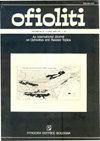西阿尔卑斯上格雷松尼谷(Upper Val Gressoney)采尔马特-萨斯(Zermatt-Saas)和蛇绿岩带分离的绿片岩相剪切带石英组构变化
IF 1.3
4区 地球科学
Q2 GEOLOGY
引用次数: 2
摘要
格雷松尼剪切带(GSZ)由一个约500米厚、剧烈变形的岩石面板组成,位于西阿尔卑斯山泽尔马特-萨斯带的高压蛇绿岩顶部。这个绿片岩相剪切带容纳了多个非同轴变形事件,具有鲜明的运动学特征。在这项研究中,详细的场测绘和结构分析结合了与GSZ相关的糜棱岩的晶体学优选取向(CPO)研究。石英CPO在剪切带中表现出系统的变化:从基底剪切带边界开始,c轴分布从II型交叉带分布转变为c轴聚集在z方向一侧(倾斜的单带)的不对称分布,再到y方向的中心簇。观察到的CPO模式与向基底接触方向增加的剪切应变一致,这可能控制了从表明基底滑动的宽外围最大值到没有最大值的倾斜单带(表明棱柱滑动),最后在棱柱和菱形滑动共同作用下在带中心产生一个细长的单最大值的转变。我们的研究结果进一步表明,在纯石英畴中,基底滑移占主导地位,而随着第二相比例的增加,棱柱滑移被激活。这些特征证实,在大多数已发表的研究中分析的几乎纯石英岩中获得的CPOs,通常与温度控制的不同滑动系统的激活有关,不能直接应用于非均质剪切带和/或多矿物糜棱岩的分析。从区域的角度来看,野外观测的构造和构造分析与西阿尔卑斯研究区自顶向东南伸展的俯冲相关高压变质作用和碰撞推覆叠加相一致。本文章由计算机程序翻译,如有差异,请以英文原文为准。
Quartz fabric variations across the greenschist facies shear zone separating the Zermatt-Saas and combin ophiolitic zones, Upper Val Gressoney, Western Alps
The Gressoney Shear Zone (GSZ) consists of a ca. 500 m thick, intensely deformed rock panel located at the top of the high-pressure ophiolitic rocks of the Zermatt-Saas Zone in the Western Alps. This greenschist-facies shear zone accommodated multiple non-coaxial deformation events with contrasting kinematics. In this study, detailed field mapping and structural analysis were integrated with the study of crystallographic preferred orientation (CPO) from mylonites associated with the GSZ. Quartz CPO displays a systematic variation across the shear zone: moving from the basal shear zone boundary, the c-axes pattern changes from type II cross-girdle distribution, to an asymmetric pattern characterized by clustering of c-axes on one side of the Z-direction (inclined single girdle), to a central cluster in the Y-direction. The observed CPO patterns are consistent with increasing shear strain toward the basal contact, which probably controls the transition from broad peripheral maxima indicative of basal slip to an inclined single girdle with no maxima, which is indicative of prism slip, and finally an elongate single maximum at the girdle centre produced by a combination of prism and rhomb slip. Our results further indicate that basal slip is dominant in pure quartz domains, whereas with increasing proportion of second phases, prism slip is activated. These features confirm that CPOs obtained from the almost pure quartzites analysed in most published studies, and generally associated with the activation of distinct slip systems controlled by temperature, cannot be straightforwardly applied to the analysis of heterogeneous shear zones and/or polymineralic mylonites. From a regional point of view, the structures observed in the field and the fabric analyses are consistent with top-to-the-SE extension post-dating subduction-related high-pressure metamorphism and collisional nappe stacking in the studied sector of the Western Alps.
求助全文
通过发布文献求助,成功后即可免费获取论文全文。
去求助
来源期刊

Ofioliti
地学-地质学
CiteScore
2.40
自引率
7.70%
发文量
1
期刊介绍:
Since 1976, Ofioliti provides an international forum for original contributions and reviews in the field of the geodynamics, petrology, geochemistry, biostratigraphy, stratigraphy, tectonics and paleogeography applied to ophiolitic terrains and modern oceanic lithosphere, including their sedimentary cover. Studies of topics such as geodynamics of the mantle, the evolution of orogens including ophiolites and paleoceanography are also welcome
 求助内容:
求助内容: 应助结果提醒方式:
应助结果提醒方式:


